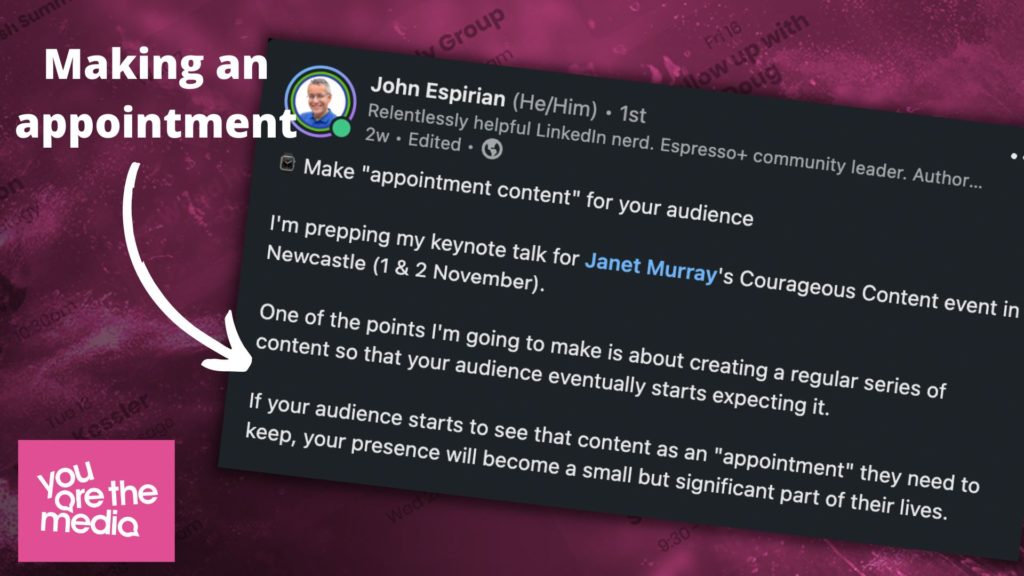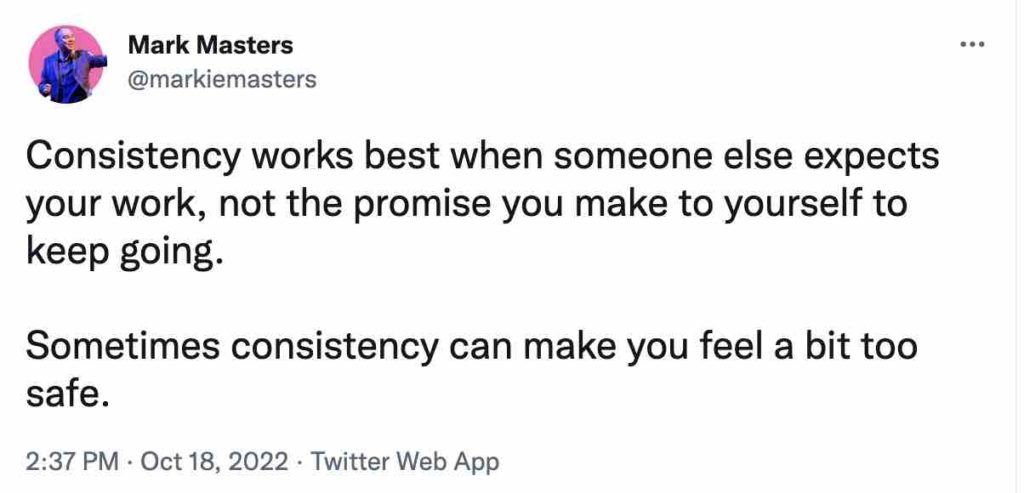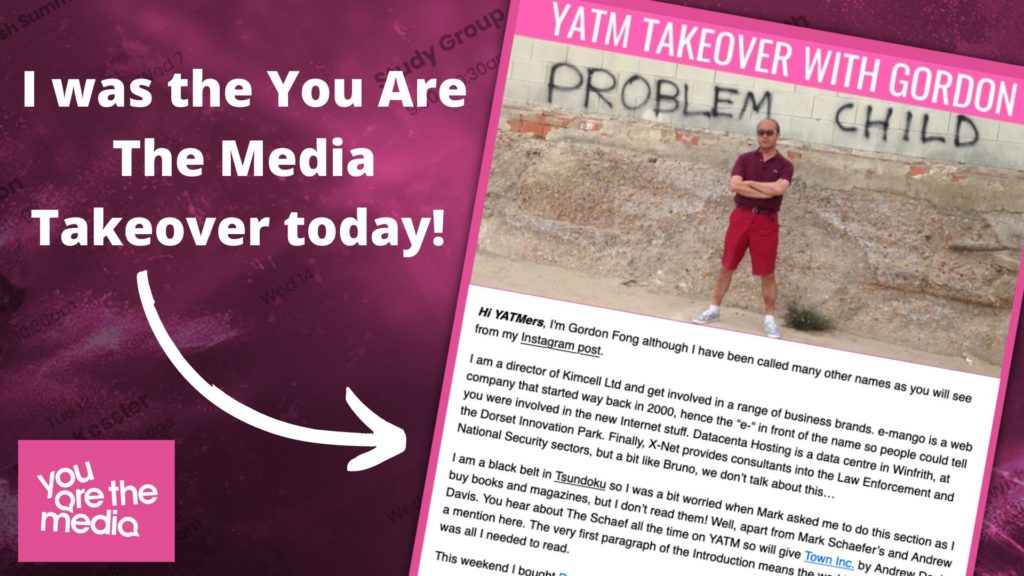How To Be Someone Else’s Routine

When your work becomes the routine of your audience, you shift from your own goal setting to being the reliable person in their week.
It is possible to make your routine, someone else’s. It’s having a system that helps you.
John Espirian shared this on consistency over time and how the work we create becomes an ‘appointment’ for others. John says, “your presence will become a small but significant part of their lives.”
The You Are The Media newsletter has been my way to book an appointment with my audience every Thursday morning. What I want to share with you here is that the small steps, week by week are what help you improve.
You can’t be swayed by the curse of comfy (routine, consistency) or pressure on the outcomes you set yourself. Over time, you make a shift from your output (the time you dedicate, the work, the putting together) to someone else’s norm (expectancy when they know you’ll show up).

Being Consistent Can Become Too Cosy
The danger of consistency is that repeated habits can start to make you feel safe.
Just because there is a day your podcast, newsletter, or video is posted, it can become a way to convince yourself that you just keep going as that’s the day you stick to. You’ve made the promise, and you stick to that promise, but is your work progressing? Consistency works when someone else expects, not the promise you make to yourself to keep going.
Sometimes the best way to keep you sharp is to stop repeating your habitual behaviour.
I see patterns from my side where around summer and the end of the year, I’m not as energetic. The projects we stand next to, do take their toll. This is where I take a break for two or three weeks and no Thursday newsletter (I let everyone know of the break). When I am back after the break, the ideas flow and I feel energised. I never want anyone to receive the newsletter that feels half-baked.
I always want to push my thinking and hopefully a receptive audience for it.
This is where that shift happens.
FROM | The routine you set yourself – the work you do
TO | The routine others have – an expectation set for someone else

When Does A Routine For Someone Else Strike Gold
A routine works, when someone else expects it.
I’d like to think that if the YATM newsletter didn’t arrive in an in-box on a Thursday, people would reach out to me asking where it is (that’s what being someone else’s routine means).
However, if I just kept the newsletter the way it was since it started, without modifying and looking to improve, it would have turned into my comfort blanket and just become a communication tick box.
What helps is to not be so hard on ourselves. That is the reason why many initiatives fail as people don’t allow enough time to look at, take a step back and make adjustments. They become campaign-led that look to drive attention. When they don’t come back with the expected outcomes, that aren’t set by the audience, they come to an end.
Not everything is going to work, read this article, this is because when you start something for the first time (from a newsletter to a podcast) you are always starting on day one. What starts to work is forming small habits, that you monitor. Over time this habit becomes transferred to your audience.
Sharing What I Do
Being someone else’s routine means starting with a system and accepting zero as your starting place. You have to be fine with making iterations and changes as you go. This is also going to save you from mediocrity (or just doing what everyone else does).
When it comes to the YATM newsletter, this is how my routine has changed.
What I used to do:
— Write the main article on a Monday evening
— Put all the effort into one main article (no other segments in the newsletter)
— Didn’t think about directing subscribers to what could be of interest (from YATM and further)
— Send Thursday AM
What I do today:
— Start writing the main article on a Monday morning and block time out with no interruptions (edit/complete 24 hours later)
— Feature others from the YATM community as the stars of the newsletter (they start every week, called the YATM Takeover)
— Put more emphasis on play and fun (time wasting section started during the pandemic as a way to do something completely unrelated to work)
— Find ways to give back to the audience that they won’t find elsewhere (apart from the newsletter) such as free nights at the theatre, to money off gin
— Add a quick links section at the top (there is quite a lot in the newsletter)
— A staggered send on a Thursday so doesn’t end up in junk folders

Shifting Your Goals
Becoming someone else’s routine means approaching with a slant that is 80% on doing and 20% on your goals.
Let me explain. If your goal is driven by the number of subscribers, clicks, or sales, then the focus is always on what you can take from the whole process. It is important but also something that you cannot control (the audience will always decide). This is what many people do when they are slanted heavier on their goals and then everything has a campaign feel.
If you put effort into focusing on your craft (80% doing) and being flexible to make adaptations based on audience feedback and looking at stats for sections you introduce, it increases your chances of producing work that has real meaning for others. This then leads to your goals.
When you put more weight towards your outputs, it becomes easier to know you have the freedom to explore. The YATM newsletter has become a routine for my audience by looking to be creative with a newsletter format (it includes video and audio too). It’s only happened by forming small habits each week.
For your side, if you want to start a newsletter, it could be starting a new habit such as writing 500 words a week. If that proves too challenging write down five ideas each week that link your business/marketplace and the values you have. The point here is to have no excuse to be vocal and shape ideas and your message.
For the YATM newsletter, it started small and what could look like a lengthy newsletter to some ie. the main article, featuring other people every week, news from around the web, and moments to play, is now a part of my weekly routine. It also means that putting together is a lot less time, the more you do. In turn, the focus on creating and not being so dependent on goals has meant a process I enjoy and has become a part of people’s week.
Let’s Round-Up
When people see you as reliable and they acknowledge that you put in the thought and work, you can become a part of their week, even their lives. You don’t need to put pressure on yourself when you know that you want to be here for the long term. You relax and give yourself permission to try something new or make changes as you progress.
No one ever decides to produce work that blends in or lacks heart and originality, it’s the ability to make small steps and gradual changes that allows your work to adjust over time, where you are tuned into the people with you.
The ultimate shift is moving from your routine to someone else’s. It can be done. When people know what to expect from you, you’ve both found the groove.
LET ME READ THIS TO YOU
Podcast: Play in new window | Download


